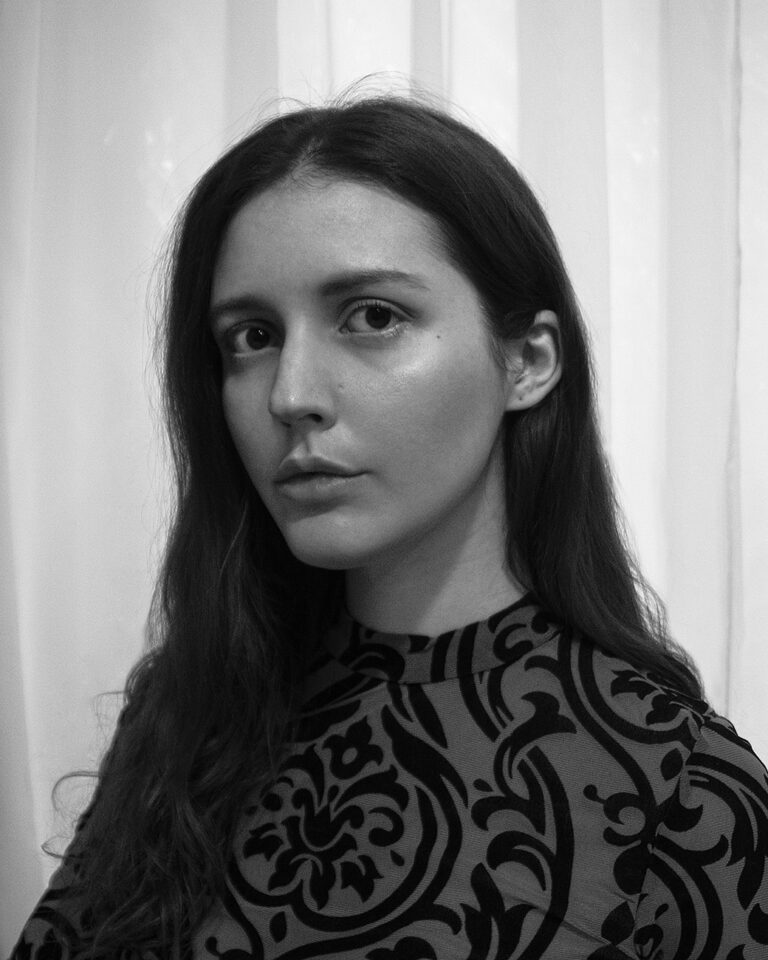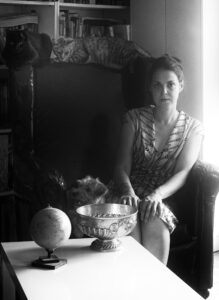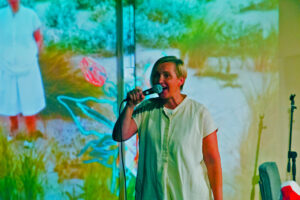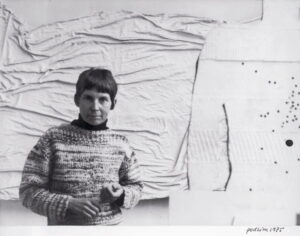Szilvia Bolla

– born in 1992. She is a visual artist based in Budapest, Hungary. After graduating from Fine Art Photography course at Camberwell College of Arts, University of the Arts London, she completed the MA Photography course of Moholy-Nagy University of Art and Design, Budapest in addition to studying Spatial Design at the Universitat der Kunste Berlin. Her exploration of the frontiers of photography as medium roots in her study of its potential for abstraction and the possible intersections between photography, installation and sculpture. Her works focuses on the sensual and ontological nature of the photographic image. She often bases this on cameraless procedures, such as the photogram or luminogram techniques, which she later blends with UV printing on thermoformed plexiglas. In recent years, Szilvia Bolla’s work has been presented at The Wrong Biennale; Trafó Gallery, Budapest; Art Quarter Budapest; Unseen Photography Festival, Amsterdam; and Vorspiel/transmediale, Berlin.
I was born and raised in the ’90s on a river island in the Danube south from Budapest. A unique wetland polluted by an illegal oil spill leaving its ecosystem irreversible and forever devastated by the end of 2020. Native to the digital era12, I grew up playing with Photoshop, digital scanners and printers while in the dawn of online microblogging the acceleration and mutation of images were getting deeply embedded in my thinking3. I remember creating artworks for Tumblr way before entering a physical contemporary gallery space. Although I consider my earliest conscious art piece a mixed media collage for a Baltimore based screamo band who I met via proto-Vampirefreaks.com, a thriving social networking site in the early 2000s dedicated to gothic subculture. Navigating endless cybernated landscapes, I used the Internet to play and explore my identity as an artist.
After getting rejected by Hungarian art schools, I left for Scotland at the age of 19 to delve into the feral scenery of the Outer Hebrides through photography. I was helplessly enchanted by the paintings of northern romanticism, the pre-Raphaelites and symbolism while learning about the possibilities of lens-based media. Later, I graduated from the fine art photography course at Camberwell College of Arts in London which radically shaped me and my practice. Fearless risk-taking and endless trust in embracing trial and error. Process-focused experiments within the post-medium condition and beyond. Pushing the boundaries of photography and doing whatever feels right.
Those who can read my work well tend to say that it has an unusual dual nature456. It’s elegant and brutal, fragile and spiky, tranquil and anxious at the same time. It resonates the same tension that is also its source of creation. I’ve come a long way before arriving at the sculptural terrain. I would call my practice crypto-photographic as the logic behind it originates to light-sensitive silver halide crystals reacting to photo-chemicals as obscure experiments in the darkroom. Photography without the burdens of representation felt so relieving as I immersed in camera-less techniques. It was a response not only to the collapse of the medium, but a world accelerating towards total uncertainty, immateriality, and the absence of presence7. Contrary to escapism or seemingly selfish formalism, photography beyond representation remained enduringly relevant by challenging technical images and vindicating reality. In that sense, the core of my research became the ontology of the photographic image8. By treating it as a tactile object, my process involved fluctuating between the analogue and the post-digital through dynamic printing and installation strategies91011.
Boundaries between image and sculpture were becoming more and more mysterious as I found myself creating material and medium hybrids. UV printing luminograms on a transparent perspex surface held an inherently captivating, even pleasing aesthetic due to its reflective, eloquent nature which I’m still recklessly challenging. It took shape in careful, frail, even overly clean sculptures with strong references to theory, however, they concealed the more intimate psychic, spiritual and material meshwork that was fueling my practice. They remained silent about the weight and pressure of their birth. I fluctuated between joy and fear when an artwork took over me when the process was more powerful than the outcome. Often, it remained my own heavy experience rather than something that anyone could easily grasp when looking at my work. I found myself on a quest to tackle such obstacles as my focus shifted towards sculptural gestures and material research. Corporeality became my true object of desire1213.
Instead of necessarily addressing content and meaning attributed to materials, I was yearning to understand their power to mutate and their plasticity. Also, within the surface lies the quality of becoming, a metamorphosis that starts from emotions and engages with the material. Inspired by the notion of thing-power; a vibrant force running across bodies whether human or non-human as introduced by posthumanist and new materialist theories14, I was interested in how my subconscious and traumas manifest on the surface of different media. The surface of matter inclined towards a healing playground for mental processes and self-analysis, a medium of communication per se15. I considered this turn as organic progress from photography to the tridimensional and the tactile, however, it was rather personal. I found relief in connecting my practice more closely with my body by drawing analogies between image surfaces and the skin16. As a shielding, yet vulnerable layer in its colour, texture, accumulated marks and blemishes, the membrane as a vital organ both records and represents on psychosomatic levels17. Paradoxically, it wounds and creates worlds18. So it has transformed into a ceaseless deconstruction and awakening of the self as an artist and a human being.1920
The final version of the statement was edited in collaboration with art historian Róna Kopeczky (2021).
1Image: Szilvia Bolla, And me I am your dagger, you know I am your wound, 2020, mirror, perspex, hygienic gel, 27x10x5cm. Photos: Dávid Biró. Courtesy of the artist and Glassyard Gallery, Budapest.2Image: Szilvia Bolla, And me I am your dagger, you know I am your wound, 2020, mirror, perspex, hygienic gel, 27 x 10 x 5cm, photos Dávid Biró. Courtesy of the artist and Glassyard Gallery, Budapest.
3Artie Vierkant, The Image Object Post-Internet, 2010, see: jstchillin.org/artie/pdf/The_Image_Object_Post-Internet_us.pdf
4Image: Szilvia Bolla, Exoskin (complete view and details), 2018, UV printed thermoformed perspex, perspex rods, PVC, metal, 170 x 150 x 30 cm, photos Krystyna Bilak. Courtesy of the artist and Glassyard Gallery, Budapest.
5Image: Szilvia Bolla, Exoskin (complete view and details), 2018, UV printed thermoformed perspex, perspex rods, PVC, metal, 170 x 150 x 30 cm, photos Krystyna Bilak. Courtesy of the artist and Glassyard Gallery, Budapest.
6Image: Szilvia Bolla, Exoskin (complete view and details), 2018, UV printed thermoformed perspex, perspex rods, PVC, metal, 170 x 150 x 30 cm. Photos by Krystyna Bilak. Courtesy of the artist and Glassyard Gallery, Budapest.
7Sandra Plummer, Duncan Wooldridge, Photography’s New Materiality? in “Photoworks” issue 18, Brighton, Photoworks, 2011.
8Tristan Garcia, The Photographic Real, Glass Bead, 2016, see: glass-bead.org/article/the-photographic-real/?lang=enview
9Image: Szilvia Bolla, Photo-Object II, 2016, clear perspex, luminogram on Fujicolor Crystal Archive paper, 60 x 40 x 30 cm. Courtesy of the artist and Glassyard Gallery, Budapest.
10Image: Szilvia Bolla: Photo-Object IV, 2017, UV printed, thermoformed perspex, 120 x 60 x 40 cm. Courtesy of the artist and Glassyard Gallery, Budapest.
11Image: Szilvia Bolla, Photo-Object VI, 2016, UV printed, thermoformed perspex, 60 x 40 x 5 cm. Courtesy of the artist and Glassyard Gallery, Budapest.
12Image: Szilvia Bolla, Prevail, 2020, thermoformed perspex, LED, 35 x 20 x 20 cm, photo Dávid Biró. Courtesy of the artist and Glassyard Gallery, Budapest.
13Image: Szilvia Bolla, Prevail, 2020, thermoplastic, metal, 130 x 80 x 20 cm, photo Dávid Biró. Courtesy of the artist and Glassyard Gallery, Budapest.
14Jane Bennett, Vibrant Matter: A Policital Ecology of Things, Durham, Duke University Press, 2010
15Giuliana Bruno, Surface. Matters of Aesthetic, Materiality, and Media, Chicago, University of Chicago Press, 2014
16Kaja Silverman, The Miracle of Analogy: Or the History of Photography, Palo Alto, Stanford University Press, 2015.
17Sara Ahmed, Thinking Through the Skin, Abingdon-on-Thames, Routledge, 2001
18Legacy Russel, Glitch Feminism, Brooklyn, Verso, 2020
19Image: Szilvia Bolla, Infinite Vytal Energies (complete view and detail), 2019, UV printed thermoformed perspex, perspex rods, metal, 160 x 120 x 30 cm. Courtesy of the artist and Glassyard Gallery, Budapest.
20Image: Szilvia Bolla, Infinite Vytal Energies (complete view and detail), 2019, UV printed thermoformed perspex, perspex rods, metal, 160 x 120 x 30 cm. Courtesy of the artist and Glassyard Gallery, Budapest.
– szül. 1992, Budapesten élő képzőművész. Miután a londoni Camberwell Művészeti Főiskola, Londoni Művészeti Egyetem képzőművészeti fotográfus szakán végzett, mester fokozatot szerzett a budapesti Moholy-Nagy Művészeti Egyetem fotográfia szakán, mindemellett térrendezést tanult a berlini Universität der Künste-n. A fotótechnikában rejlő absztrakciós lehetőségek, valamint a fotográfia installációval, illetve a szobrászattal való metszéspontjainak vizsgálata vezette érdeklődését a fotó, mint médium határterületei felé. Munkái középpontjában a fotografikus kép érzéki és ontológiai természetének vizsgálata áll. Mindez gyakran alapul a fényképezőgép használatát nélkülöző eljárásokra, így például a fotogram vagy a luminogram technikájára, amiket később UV nyomtatással vegyít, hővel formált plexiüvegen. Az elmúlt években Bolla Szilvia munkáit bemutatták többek között a ‘The Wrong Biennale’-n, a budapesti Trafó Galériában, az Art Quarter Budapestben, az amszterdami Unseen Photography Fesztiválon, valamint Berlinben a Vorspiel / transmediale-n.
A ’90 -es években születtem és nevelkedtem a Duna egyik szigetén, Budapesttől délre. Ez egy egyedülálló vízi élővilág, melynek ökoszisztémáját az illegális olajszennyezés 2020 végére visszafordíthatatlanul és végérvényesen elpusztította. A poszt-digitális kor bennszülöttjeként12 a Photoshoppal, digitális nyomtatókkal és szkennerekkel kísérletezve nőttem fel, miközben az online mikroblogolás hajnalán a képfolyam felgyorsulása és változásai mélyen beágyazódtak a gondolkodásomba3. Emlékszem, hogy műveket készítettem a Tumblr-re, még jóval azelőtt, hogy betettem volna a lábam egy valódi kortárs galériába. Bár legkorábbi tudatosan létrehozott művem egy vegyes média kollázs volt, amit egy baltimore-i screamo zenekar számára készítettem, akikkel a 2000-es évek elején virágzó, a gótikus szubkultúrának szentelt Vampirefreaks.com közösségi oldalon találkoztam. Végtelen kibernetikus tájakon navigálva az interneten játszottam és fedeztem fel művészi identitásomat.
Miután elutasítottak a magyar művészeti iskolák, 19 évesen Skóciába indultam, hogy a fotográfián keresztül fedezzem fel a Külső Hebridák vad tájait. Menthetetlenül elvarázsoltak az északi romantizmus, a pre-Rafaeliták, valamint a szimbolizmus festményei miközben kiismertem a fotográfia médiumában rejlő lehetőségeket. Végül elvégeztem a londoni Camberwell College of Arts képzőművészeti fotográfus kurzusát, amely alapjaiban határozott meg engem és a művészeti gyakorlatomat. Félelemtől mentes kockázatvállalás és végtelen bizalom a próbálkozás és kudarc elfogadásában. Folyamatközpontú kísérletezések a poszt-médium kondícióján belül és azon túl. Feszegetve a fotográfia határait, és mindent megtéve, amit helyesnek érzek.
Aki értelmezni tudja a munkámat, hajlamos azt mondani, hogy szokatlan, kettős természete van456. Elegáns és brutális, törékeny és tüskés, nyugodt és szorongó egyszerre. Ugyanaz a feszültség árad belőle, amely egyben a létrehozásának forrása is. Hosszú utat tettem meg mielőtt megérkeztem a szobrászat területére. A praxisomat kriptfotográfiának nevezném, mivel a mögötte meghúzódó logika a fényérzékeny ezüst-halogenid kristályokra vezethető vissza, amelyek a fényérzékeny vegyianyagokra reagálnak, mint homályos kísérletek a sötétkamrában. Ahogy belemerültem a kamera nélküli fotográfiába, a reprezentáció terhétől mentes fotózás megkönnyebbülést hozott. Válasz volt nemcsak a médium összeomlására, hanem a teljes bizonytalanság, anyagtalanság és a jelenlét hiánya felé vágtázó világra is7. Az eszképizmussal vagy a látszólag önző formalizmussal ellentétben a reprezentáción túli fotózás tartósan releváns maradt a technikai képek és a valóság megkérdőjelezésében. Ebben az értelemben a fotográfiai kép ontológiája vált a kutatásom lényegévé8. Tapintható objektumként tekintve rá, alkotási folyamatom a dinamikus nyomtatási és installációs stratégiák révén ingadozik az analóg és a poszt-digitális között91011.
A kép és a szobor közötti határok egyre rejtélyesebbé váltak, ahogy azon kaptam magam, hogy anyagbeli és médiumbeli hibrideket hozok létre. Az UV-nyomtatású luminogramok esztétikája az átlátszó plexi magával ragadó, sőt, kellemes a reflektív, kecses természetüknek köszönhetően, amellyel folyamatosan kísérletezem. Mindez gondos, törékeny, sőt túlságosan tiszta, elméletre hivatkozó szobrokban öltött testet, azonban magukba rejtették a praxisomat tápláló, intimebb, szellemi és anyagi hálózatot is. Hallgattak a születésük terhéről és nyomásáról. Az öröm és a félelem között ingadoztam, amikor egy mű felülkerekedett rajtam, amikor a folyamat erősebb volt, mint az eredmény. Gyakran ezt a nehézséget csak én tapasztaltam meg, és a munkáimat nézve, mások számára ez nem volt érzékelhető. Ilyen akadályok leküzdésére törekedtem, miközben fókuszom szobrászati gesztusok és az anyagkutatás felé fordult. A testiség vált a vágyam igazi tárgyává1213.
Az anyagnak tulajdonított tartalommal és jelentéssel való foglalkozás helyett arra vágytam, hogy megértsem a plaszticitásukat és a változásra való képességüket. Emellett a felszínen belül rejlik a valamivé válás minősége, egy metamorfózis, amely az érzelmekből indul ki és kapcsolódik az anyaghoz. A dolog-hatalom fogalmából és a poszt-humanista és az új materialista elméletek14 által leírt – akár emberi, akár nem emberi – testeken végigfutó életerőből inspirálódva az foglalkozatott, hogy a tudatalattim és traumáim hogyan jelennek meg a különböző médiumok felületén. Az anyag felülete a mentális folyamatok, önanalízis eszközévé, a kommunikáció közegévé vált15. Ezt a fordulatot organikus haladásnak tekintettem a fotográfiától a háromdimenziós és a tapintható felé, azonban ez inkább személyes volt. Megkönnyebbülést tapasztaltam abban, hogy gyakorlatomat szorosabban összekötöttem a testemmel, analógiákat vonva a képfelületek és a bőr között16. Színében, textúrájában, felhalmozódott nyomaiban és foltjaiban, a membrán létfontosságú szervhez hasonlóan rögzít és reprezentál pszichoszomatikus szinten17. Paradox módon sebeket ejt és világokat teremt18, mind a művészi, mind az emberi én szüntelen öndekonstrukciójává és ébredezésévé válva1920.
A statement végleges formája Bolla Szilvia és Kopeczky Róna művészettörténész együttműködésében jött létre (2021).
1Kép: Bolla Szilvia, And me I am your dagger, you know I am your wound, 2020, tükör, perspex, higiéniai zselé, 27 x 10 x 5 cm, fotó Biró Dávid. A művész és a Glassyard galéria jóvoltából.2Kép: Bolla Szilvia, And me I am your dagger, you know I am your wound, 2020, tükör, perspex, higiéniai zselé, 27x10x5 cm, fotó Biró Dávid. A művész és a Glassyard galéria jóvoltából.
3Artie Vierkant, The Image Object Post-Internet, 2010. Lásd: jstchillin.org/artie/pdf/The_Image_Object_Post-Internet_us.pdf
4Kép: Bolla Szilvia, Exoskin (teljes nézet és részletek), 2018, UV nyomtatott hőformázott perspex, perspex pálcák, PVC, fém, 170 x 150 x 30 cm, fotók Bilák Krystyna. A művész és a Glassyard galéria jóvoltából.
5Kép: Bolla Szilvia, Exoskin (teljes nézet és részletek), 2018, UV nyomtatott hőformázott perspex, perspex pálcák, PVC, fém,170 x 150 x3 0 cm, fotók Bilák Krystyna. A művész és a Glassyard galéria jóvoltából.
6Kép: Bolla Szilvia, Exoskin (teljes nézet és részletek), 2018, UV nyomtatott hőformázott perspex, perspex pálcák, PVC, fém, 170 x 150 x 30 cm, fotók Bilák Krystyna. A művész és a Glassyard galéria jóvoltából.
7Sandra Plummer, Duncan Wooldridge, Photography’s New Materiality? in “Photoworks” 18. szám, Brighton, Photoworks, 2011
8Tristan Garcia, The Ontology of Photography, Glass Bead, 2016. Lásd: glass-bead.org/article/the-photographic-real/?lang=enview.
9Kép: Bolla Szilvia, Photo-Object II, 2016, tiszta perspex, luminogram, Fujicolor Crystal Archive papír, 60x40x30 cm. A művész és a Glassyard galéria jóvoltából.
10Kép: Bolla Szilvia, Photo-Object IV, 2017, UV nyomtatott, hőformázott perspex, 120 x 60 x 40 cm. A művész és a Glassyard galéria jóvoltából.
11Kép: Bolla Szilvia, Photo-Object VI, 2016, UV nyomtatott, hőformázott perspex, 60 x 40 x 5 cm, A művész és a Glassyard galéria jóvoltából.
12Kép: Bolla Szilvia, Prevail, 2020, hőformázott perspex, LED, 35 x 20 x 20 cm, fotó: Biró Dávid. A művész és a Glassyard galéria jóvoltából.
13Kép: Bolla Szilvia, Prevail, 2020, hőre lágyuló műanyag, fém, 130 x 80 x 20 cm, fotó Biró Dávid. A művész és a Glassyard galéria jóvoltából.
14Jane Bennett, Vibrant Matter: A Political Ecology of Things, Durham, Duke University Press, 2010.
15Giuliana Bruno, Surface. Matters of Aesthetic, Materiality, and Media, Chicago, University of Chicago Press, 2014
16Kaja Silverman, The Miracle of Analogy: Or the History of Photography, Palo Alto, Stanford University Press, 2015
17Sara Ahmed, Thinking Through the Skin, Abingdon-on-Thames, Routledge, 2001
18Legacy Russel, Glitch Feminism, Brooklyn, Verso, 2020
19Kép: Bolla Szilvia, Infinite Vytal Energies (teljes nézet és részlet), 2019, UV nyomtatott, hőformázott perspex, perspex pálcák, fém, 160x120x30 cm. A művész és a Glassyard galéria jóvoltából.
20Kép: Bolla Szilvia, Infinite Vytal Energies (teljes nézet és részlet), 2019, UV nyomtatott, hőformázott perspex, perspex pálcák, fém, 160x120x30 cm. A művész és a Glassyard galéria jóvoltából.



